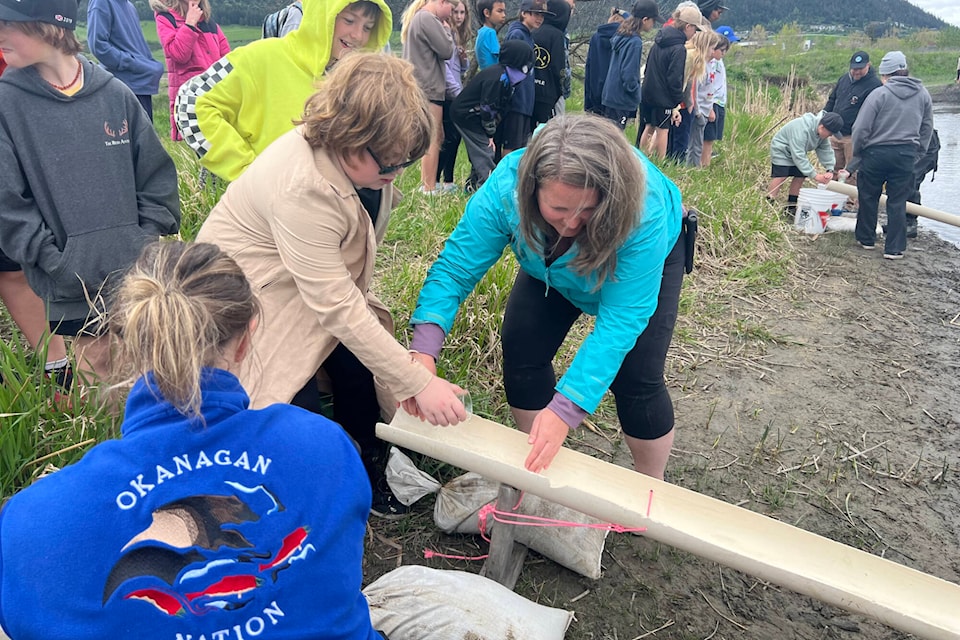A decades long effort to restore sockeye salmon in the Okanagan reached a new chapter in Vernon Tuesday, May 7.
Young students from Okanagan Landing Elementary and the Okanagan Indian Band’s school took part in the Okanagan Nation Alliance (ONA)’s second annual sockeye fry release ceremony. More than 3,300 sockeye fry were released into Lower Vernon Creek at the Marshall Field dog park.
Students held the small salmon fry in a cup — covering it with their hand to keep them from jumping out — and took turns pouring them into the creek.
This year marks two decades of efforts to conserve and restore sockeye salmon populations in the Okanagan, and the fry release provided a direct connection to the salmon reintroduction efforts, while creating new stewards who have an appreciation for the restoration and preservation of salmon and their habitat.
The fry come from the ONA’s kł cp̓əlk̓stim̓ hatchery. Opened in 2014, the 25,000-square-foot hatchery has the capacity to rear eight million eggs.
Tyson Marsel, ONA hatchery biologist, explained that a dam in Penticton has prevented salmon from returning to their many spawning habitats connected to Okanagan Lake, with Lower Vernon Creek being one of those systems.
“By reintroducing these fish back into the system where they once used to spawn, we hope that once they return as adults, they’ll make their way back into these systems to spawn,” Marsel said.
Marsel said for the past six years, salmon have had access to Okanagan Lake after a passage was created for the fish in Penticton. That passage allows the salmon to spawn in Okanagan Lake, and for the past two years the fish have been able to fully access the entire system and can spawn in multiple tributaries connected to the lake.
In total, ONA will be releasing 1.5 million fish from the hatchery this year.
Marsel said putting fish into the water system is only one piece of the puzzle when it comes to restoring salmon populations. Habitat restoration is equally important, he said.
“By the combined work of habitat restoration and putting the fish back into the system, that’s where all the work is going to come together and we’re going to slowly rebuild that (salmon) run.”
The hatchery raises both chinook and sockeye salmon, but its main focus is on restoring sockeye populations. That’s partly because chinook are very endangered, and the hatchery was only able to capture two female chinook, yielding about 5,500 eggs, whereas they were able to catch more than 600 female sockeye salmon and recover 1.5 million eggs.
Marsel said getting kids involved in the fry release ceremony fulfills one of ONA’s goals.
“We want to create the next stewards of the land,” he explained. “Part of bringing youth to these events is to create that next generation of stewards, where they are going to be the ones creating that future for the salmon. They’re going to be the ones coming as technicians and hatchery biologists.”
Last year was ONA’s first sockeye salmon fry release into Lower Vernon Creek, with roughly 120,000 fish.
A similar fry release was held at Shingle Creek in Penticton last week, and more releases will soon take place at Kelowna’s Mission Creek, Six Mile Creek by the OKIB Fire Hall, Castlegar, Slocan, Revelstoke, Spallumcheen and more. The dates and times for each release can be found on ONA’s website syilx.org/events/fry-releases/.
READ MORE: Canada makes assessment of tire chemical tied to salmon deaths a priority
READ MORE: Kids get hooked on catching fish in Vernon
